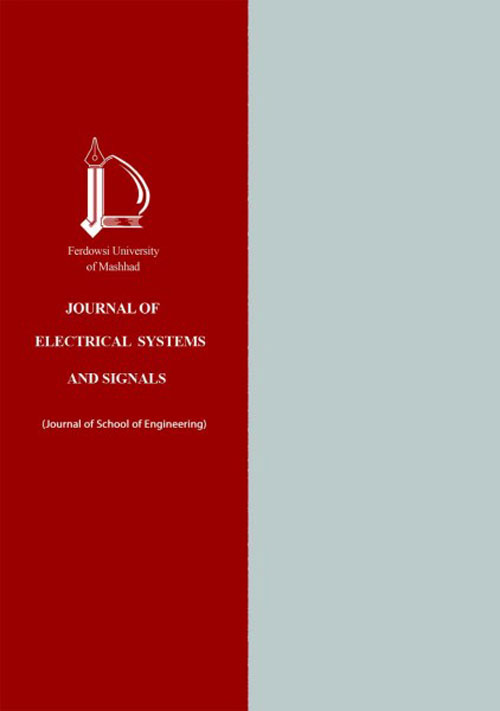فهرست مطالب
Journal of Electrical Systems and Signals
Volume:2 Issue: 1, 2014
- تاریخ انتشار: 1393/09/30
- تعداد عناوین: 6
-
Accelerated Local Binary Fitting Scheme for Medical Images SegmentationPages 1-8Geometric and geodesic active contours are typical approaches for medical image segmentation. Specially, local binary fitting (LBF) effectively takes advantage of the local intensity average in the energy functional to overcome segmentation difficulties caused by intensity inhomogeneity and ruptured edges. Despite promising results, the convergence rate of LBF is too slow. In this paper, we proposed a new efficient implementation for LBF based on the additive operator splitting scheme. In more detail, the multi-dimensional deformation equation of LBF is decomposed into some one-dimensional equations which can be efficiently solved by Toma's algorithm. Experimental results demonstrated that the proposed algorithm performs better than LBF in terms of both CPU time and solution quality.Keywords: Geometric Active Contours, Level Set, Local Binary Fitting, Additive Operator Splitting, Image Segmentation
-
Progressive SAR Image Compression Using Low Complexity Bandlet Transform and Modified EZBCPages 9-14In this paper, we introduce a progressive SAR image compression based on bandlet transform (BT) and a modified Embedded Zero-Block Coding (EZBC) algorithm. BT as a new developed adaptive multi-resolution geometry analysis tool exhibits enormous potential in compression based on geometric regularity. Since in SAR images, important information is spread in the entire frequency spectrum, discrete wavelet transform (DWT) cannot provide optimal representation and instead BT is employed to provide a sparse representation of the image. A modified version of EZBC algorithm is introduced to efficiently encode the bandlet coefficient in a progressive manner in which fidelity of the reconstructed image in the decoder gradually improves as more bits are received and decoded. Numerical tests show that our method provide a significant improvement particularly for low bit rate SAR image compression.Keywords: SAR, DWT, bandlet transform, EZBC, progressive image coding
-
The effect of adding InGaN interlayer on AlGaN/GaN Double-Channel HEMT for noise improvementPages 15-20High-performance of Al0.3Ga0.7N/GaN high electron-mobility transistors (HEMTs) with 1µm gate length are investigated by TCAD. The device exhibit a transconductance of about 110 ms/mm at VDS=9 V and a minimum noise figure (NFmin) of 0.65dB at 10 GHZ. Also we inserted a 21nm Al0.05Ga0.95N bottom barrier layer at a location that is 14-nm away from the AlGaN/GaN heterointerface. This structure shows a transconductance of about 135 ms/mm at VDS=9 V and a minimum noise figure (NFmin) of 0.54dB at 10 GHZ that is better than conventional AlGaN/GaN HEMT. For further improvement we inserted a 3nm InGaN layer at a location that is 6-nm away from the Al0.05Ga0.95N/GaN heterointerface. The In0.1Ga0.9N causes high polarization charge which makes a high barrier potential and prevents carrier to go into substrate. Due to high carrier density and high mobility AlGaN /GaN DC-HEMT with InGaN shows higher transconductance of 165 ms/mm at VDS=9 V and lower NFmin of 0.45 dB at 10 GHZ than Al0.3Ga0.7N/GaN DC- HEMT. Also the noise characteristics of AlGaN/GaN DC-HEMT with InGaN is calculated as a function of gate voltage as well as drain voltage and shown that with increase of transconductance noise decrease.Keywords: AlGaN, GaN, Double Channel (DC) HEMTs, InGaN, Minimun Noise Figure (NFmin)
-
Investigation of a SiGe tunnel FET: comparison to Si and Ge TFETsPages 21-26In this paper a SiGe p+n+in+ tunneling transistor is studied and compared with Si and Ge based transistors. Moreover, in the proposed structure a -doped n+ region is considered between the source and the channel, and this region is optimized in the sense of region width (Wd) and doping level for the highest ratio of on-current to off-current and the lowest sub-threshold swing. Simulations show that Ion/Ioff ratio greater than 11 order of magnitude and sub-threshold swing of 16.6 mv/dec, which is well below 60 mv/dec limit of conventional MOSFETs, are obtained.Keywords: Tunnel FET, I-on, I-off ratio, Band, to, Band tunnelling, off, current, sub, threshold swing
-
New Dual-mode SIW Filter Using Corner Cut PerturbationPages 27-32This paper presents a new square SIW cavity that is perturbed by displacement of corner vias as a corner cut perturbation. This perturbation causes mode splitting of degenerate modes (TE102 and TE201) of the square SIW cavity. A dual mode filter using this cavity is realized with 2.8% FBW at 6.1GHz and two transmission zeros at 5.55GHz and 6.81GHz. This filter is modeled by the coupling matrix representation based on the global eigen modes and also, the simulation and measurement results of this filter are presented.Keywords: SIW cavity, dual mode filter, coupling matrix
-
Long-range plasmonic waveguides with polymer claddingsPages 33-38Metallic surfaces can support surface-bound guided optical modes through interaction of the optical field with the electron density oscillations. Propagation of these surface waves, also called surface plasmon polaritons, is a very lossy process, due to mode overlap and heat dissipation within the metal. In principle thin metal stripes can support longer propagation lengths, however in the fabrication process it is imperative to balance the refractive index of the claddings. In this paper different techniques for fabricating long-range plasmonic waveguides are presented, together with results of optical characterization of the fabricated samples. The waveguides are fabricated using gold and the claddings are chosen to be SU-8 and PDMS polymers.Keywords: Plasmonics, long range surface plasmons, SU, 8, PDMS, metals, surface adhesion, microfabrication, optical waveguides


